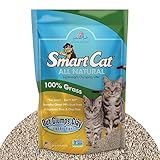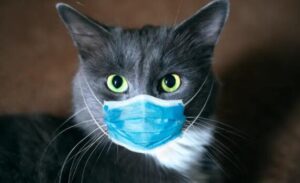 One task faced with cat owners new and old is the dreaded litter problem. There are numerous varieties of cat litter on the market, and choosing which one is the best cat litter for your cat’s health can seem like a daunting task.
One task faced with cat owners new and old is the dreaded litter problem. There are numerous varieties of cat litter on the market, and choosing which one is the best cat litter for your cat’s health can seem like a daunting task.
The list of litter types varies, as does the functions of each one. Most focus on controlling odor. Several are created specifically for multiple-cat households.
But a key factor often overlooked by most people when choosing the ideal litter type for their pet is: “is this particular type of cat litter healthy for their cat?”
Table of Contents
What Is the Best Cat Litter For Your Cat’s Health?
Pick the Best Cat Litter For Your Cat’s Health
What Types of Cat Litter Are Best For Your Cat’s Health?
That question can be a confusing one for most people. Ideally, litters crafted from natural products that pose no danger to the cat’s health, as well as the health of their owner, are typically considered to be the better options. Newspaper, wood shavings and/or sawdust, pine pellets, or litter made from annual renewable tree-nut crops are just some examples of more natural, greener options.
Clumping cat litters
Most mass-produced cat litters contain high amounts of silica dust, which have been linked to the development of upper respiratory problems in both cats and even humans.
Another issue is the addition of sodium bentonite clay in the clumping cat litter varieties. This type of clay can swell up to 15 times more than its original volume whenever a cat urinates or defecates onto it, admittedly making it an excellent addition to cat litter.
The waste clumps up and can be scooped out without the need to change the entire litter box outright. However, if a cat consumes litter containing the bentonite clay, it can cause mild to severe gastrointestinal problems, and in worst-case scenarios, could ultimately spell death.
To add insult to injury, this common clay ingredient is, more often than not, obtained via strip mining, a process that is both taxing and unethical for the environments practiced upon.
Litters made by the newspaper
Rest easy, though, as greener options are available. These bio-friendly alternatives get the job done effectively while remaining healthy options for both cats and their owners.
Some litters have been formulated from recycled newspapers, many of which have reportedly shown to be roughly three times more absorbent than their bentonite clay counterparts alone.
The newspaper collected is non-toxic and fragrance-free, yet it still proves effective against odors. It is also 99.7 percent dust-free, tagging on another plus for the household’s respiratory health.
Some newspaper-based cat litters are also packaged in biodegradable or recyclable paper packaging.
Yesterday’s News’ Cat Litter is one such product.
Wood chips
Another health-conscious alternative for litter is, surprisingly, wood shavings and/or sawdust. Wood chips are inexpensive and easy to both use and handle. They carry a pleasant aroma, are compostable, and are biodegradable. Plus, they too are dust-free.
NEPCO’s CederificNatural Cat Litter, Feline Pine, and Bettwe Way Cat Litter are some examples of cat litter wood-based litter.
Tree-nut crops
Tree-nut crops are another surprising ingredient. These litters are created using a combination of fibrous material derived from tree-nut crops, which are renewed annually.
Wheat
Cat litters that employ natural enzymes from renewable wheat sources to help control odors are also available. In addition to being compostable and biodegradable, these are also low-tracking and a low-dust litter.
sWheatScoop Natural Wheat Litter is a prime example of this.
Corn and vegetable
Corn and vegetable derivatives can likewise be used. Whole kernel corn is used to make World’s Best Cat Litter. Vegetable derivatives and non-genetically modified maize can also be used to make cat litter.
All-natural cat litters
Cat litter made from natural materials can be composted as well. This is, naturally, a great way to create rich soil for your garden, as well as to contribute to the minimalization of landfill waste.
Making own cat litters
Eco-conscious cat owners can, of course, make their own cat litter. This can be done by repurposing everyday items that would otherwise wind up being thrown out to contribute to ever-growing landfill piles.
Ordinary, plain sawdust does make a great cat litter but doesn’t necessarily control odor by itself, therefore some other substrate like baking soda should be added. Depending upon where one lives, however, this could be hard to find.
Newspapers can also be turned into cat litter, and although this process takes a little bit of elbow grease, it can save substantial money in the long run.
How to Pick the Best Cat Litter For Cat’s Health?
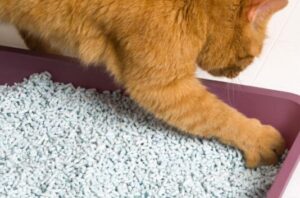
Should the Litter Be Scented?
The main reason people use scented cat litter is to mask the odor of their pet’s less than the pleasant litter box. However, the chemicals used in scented litters don’t actually eliminate the smell of a cat’s urine, and can actually be toxic to your cat. Covering up bad smells with other pleasant smells can prove bad for your cat’s health. Before purchasing scented cat litter, there are a few things to consider in respect to your cat’s health:
- Cats will breathe in the artificial scent of the litter.
Since their sense of smell is more developed than that of a human’s, the scent is far stronger for them. The dust from the litter will cling to their fur, and they will be smelling it all day long.
- Cats can accidentally eat this artificial litter when they are cleaning their paws.
Some litters haven’t been tested for toxicity, so this is putting your cat at risk for further health complications.
- Sneezing fits, weeping eyes, and mattering of the cat’s eyes, and URI (upper respiratory infections) are linked to the artificial dust.
- Heavily scented litters can “repel” your cat away from their litter box, resulting in accidents around your home.
- For a more natural scent, add baking soda to your cat’s litter instead.
Put a thin layer on the bottom of the cat’s litter pan. It will help absorb odors without using harsh chemicals.
- Try using the right amount of cat litter.
Make sure there is a proper amount of cat litter to balance out the amount of your cat’s waste to help eliminate the smell.
- Clean the litter box daily.
Scoop out the solid materials at least once or twice per day. Change the litter out often and sanitize your cats litter pan monthly with a solution of hot soapy water and white vinegar. This kills germs while remaining gentle enough for your cat to breathe without worry, as opposed to bleach.
Does It Control Odor
The chief complaint when it comes to picking a litter for your cat is: “Does it control odor?” Your cat’s litter box might be the first thing your guests smell when they walk into your home for the very first time. To make sure you create a great first impression and to have a clean smelling household a litter which helps control odors can help.
In the organic line of cat litters. Some are flushable, biodegradable and most are reasonably priced. One such product is called Okocat Super Soft.
Okocat Super Soft Cat Litter For Odor Control Reviews
It is a clumping wood litter, compared with other types of litters, it absorbs five times its own weight before it gets too messy to handle with ease. After buying this, you will find it superb at odor control and can handle multiple cats and odors for up to seven days. Since it is made from natural products it is able to be flushed should you choose to dispose of the litter that way. It is also biodegradable so no matter how you choose to dispose of it you can take comfort in the fact that it will not have a negative effect on the environment.
Why Is It Beneficial to Cat’s Health:
- It absorbs better than almost any other cat litter.
- It is a flushable litter and is naturally biodegradable
- It is also reasonably priced.
However, it doesn’t clump as well and can leave some tracks.
Feline Pine Natural Cat Litter to Eliminate Bad Odor
Feline Pine is another natural cat litter. However, it can not be flushed. It is a little pricier of the natural cat litters, but t definitely has the benefits of using it. The first being odor control. It kills odors on contact so there shouldn’t be a problem with bad-smelling your home when using this litter. It’s very absorbent also, but it doesn’t clump together when your cats use it so the entire litter box would have to be dumped when the time comes to change it.
Why Is It Beneficial to Cat’s Health:
- It eliminates basic odors right away when your cat uses the litter box.
- It is also dust-free.
- It is safe to ingest if you have a cat that eats litter.
However, it is not flushable and it can be a little bit pricey.
Other Things to Consider
Whatever type of natural cat litter you choose it is important to pick the one which will also appeal to your cat.
● Pick the right type of cat litter.
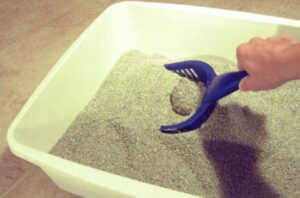
There are numerous different types of cat litters. Some are made with corn, paper, wheat, walnut, and wood. Above all, you want to choose a cat litter that is safe for your cat. Be aware of any allergies that your cat has as well.
● Be alert for false claims.
Simply because a product says it is natural does not mean that it doesn’t contain harmful chemicals which you wouldn’t want near your cat or inside of your home. Do your research before buying any cat litter.
● Don’t start out with a big bag of litter.
Since you can’t predict how your cat will react to a particular type of cat litter it is best to invest in a small bag to start out with.
● Purchase litter for the number of cats in your household.
Some litter is not suited for multiple cat households. Make sure the litter you purchase can keep up with the amount of waste and smell they produce.
Natural litter is the safest for your cat however you should choose the one that fits your needs and is right for your cat.
Cat Litter And Your Cat’s Health
Cat litter can make your cat sick. A clay-based cat litter contains crystalline silica. Silica is the main component in mineral ores, rock, and sand. The health threat comes from the silica dust which can get into the air and be breathed in by both cats and their owners. Prolonged exposure to the silica dust causes silicosis which is a non-cancerous, but sometimes fatal lung disease. The crystalline silica is also a suspected carcinogen that has been associated with bronchitis and tuberculosis.
Respiratory problems aren’t the only health concern to consider when purchasing a cat litter for your pet. As all cats clean their fur and paws they can ingest the clay cat litter if it is on their paws. Clumping cat litters when ingested will expand and absorb moisture in the cat’s intestines. This causes blockages and dehydration. It also prevents the cat’s body from absorbing nutrients.
Common Problems Caused By Cat Litter
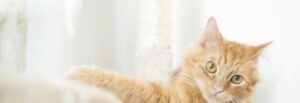
One common problem caused by cat litter is something called Toxoplasmosis. It is a disease that results from becoming infected with the Toxoplasma gondii parasite. This is one of the world’s most common parasites. Normally, infection occurs from eating contaminated meat which has not been thoroughly cooked, mother-to-child transmission during pregnancy, or from being exposed to infected cat feces.
Most people infected with toxoplasmosis never develop any signs or symptoms. Some people who do show signs develop flu-like symptoms. For infants born to infected mothers or anyone with weakened immune systems, toxoplasmosis can cause some serious complications.
If you are not pregnant, are generally healthy, and been confirmed to have toxoplasmosis chances are that you won’t need any treatment other than conservative management. However, if you are pregnant or your immune system is compromised you may need medical treatment to prevent severe complications.
Signs and symptoms of Toxoplasmosis are similar to the flu.
- Body aches
- Fever
- Fatigue
- Headache
- Swollen lymph glands
For people with weakened immune systems, the symptoms are different. If you are receiving chemotherapy, have recently had an organ transplant, are infected with HIV/AIDS, or have had a recent toxoplasmosis infection it may reactivate and produce more severe symptoms such as:
- Headache
- Poor Coordination
- Seizures
- Confusion
- Blurred vision caused by severe inflammation of the retina (ocular toxoplasmosis)
- Lung problems which may resemble tuberculosis or Pneumocystis jiroveci pneumonia (a common opportunistic infection that occurs in patients with AIDS)
In babies:
If you become infected and are pregnant or become pregnant you can transmit the infection on to your baby(congenital toxoplasmosis). Your baby is most at risk during the first trimester.
Many early infections result in stillbirths or a miscarriage. Infants who survive are very likely to be born with very serious problems. These include:
- Seizures
- Severe eye infections
- An enlarged liver or spleen
- Jaundice (yellowing of the skin and the whites of the eyes)
Prevention:
- Wear gloves when changing your cat’s litter box and wash your hands thoroughly afterward.
- Have someone else clean your cat’s litter box if you are pregnant.
- Change your cat’s litter box daily to prevent excreted cysts from becoming infected.
Conclusion
In conclusion, the most important thing to consider when choosing the right litter for your cat is the health of both you and your pet. In addition, one should find a balance between controlling odors, and preventing illness for either you or your cat in the process. Save yourself not just expenses on litter, but on costly vet bills and heartache. Because if there is one thing your cat should do on a daily basis, it should not be making them sick.

